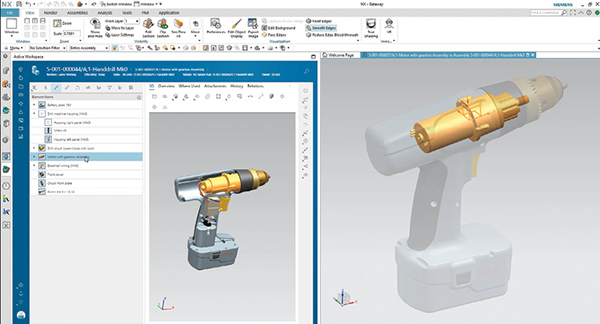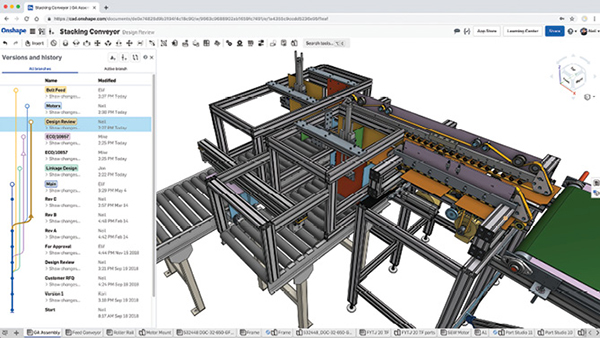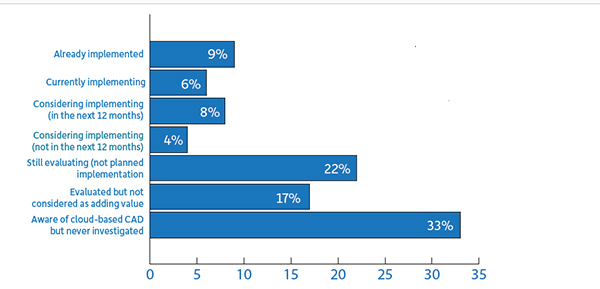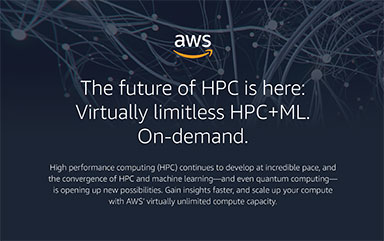
Siemens PLM integrates PDM capabilities inside both of its CAD products: NX and Solid Edge. Image courtesy of Siemens PLM Software.
Latest News
July 1, 2019
If you do a search on the phrase, “engineer hours spent looking for information,” you’ll find a bunch of reports that riff on the same tune: knowledge workers, including engineers, spend a significant part of their day looking for information.
In recent years, cloud-based product data management (PDM) has been promoted as a way to improve access to information by streamlining and centralizing all product data, whether it is CAD or other file-based data types.
A 2017 study by Jon Peddie Research and Business Advantage says the engineering industry is looking at cloud technology, but for the most part companies were either still kicking tires or otherwise not investing in it.
The report examined both cloud-based CAD technology and cloud-based PDM.
“We believe there is more work that can be done to change attitudes toward CAD in the cloud,” the report says. “At many sites, it is a top-down process as company executives opt for the predictability of subscriptions and cloud-based provisioning.

“CAD/CAM/CAE users are at the early stages of cloud-based workflows,” the report continues. “Software vendors are confident of the benefits of leveraging the cloud and are developing products for their customers. However, there is a mismatch in definitions and expectations between customers and vendors, causing an adoption delay, but we are seeing customer attitudes change very quickly from entrenched positions to acceptance.”
For this article, we are separating PDM from product lifecycle management (PLM) solutions. PDM systems provide deep control of CAD models, whereas PLM systems manage the broad knowledge about product definition and lifecycle issues such as configuration, regulatory management and audits.
“I see a strong adoption for cloud file storage across many companies these days,” says Oleg Shilovitsky, CEO and co-founder of OpenBOM, which straddles the boundary between PDM and PLM by providing a cloud-based platform for bill of materials (BOM) and inventory management. “PDM is still far from retirement, and there is no good candidate to replace it.”
Shilovitsky sees growing ad hoc implementation of general purpose cloud storage tools including Dropbox, Microsoft OneDrive Enterprise and Google Drive. “The question if PDM systems can leverage this storage is a good one; you can find heated debates about it online,” he says.
Crawling to Cloud Services Adoption
Synergis Software sells Adept, which it describes as an Engineering Information Management platform that includes PDM capabilities. Today, half of Synergis Adept customers are in manufacturing, the other half are in utilities and architecture, engineering and construction (AEC). In 2018 Synergis introduced a new web-based architecture for Adept.
“Today most CAD data is on local networks,” says Todd Cummings, the VP of research and development at Synergis. “We are seeing more IT departments hosting infrastructure on the cloud. Instead of purchasing new servers, they rent more space on Azure, AWS, [Amazon Web Services] and others and use hosted apps.” Cummings says this gradual migration to cloud services by IT administrators will be a key driver of moving CAD collaboration to the cloud.
Cummings states manufacturers, especially the smaller companies, “are lagging behind other industries in becoming cloud-centric.” Despite being “20 years after most of us moved to online banking,” manufacturing companies are just now thinking of how to move to cloud-based collaboration.
He still hears criticisms regarding security, despite overwhelming research “that shows data in the cloud is more secure than data on your network,” he says.
Cummings sees attitude and institutional biases as a strong factor that continues to impede adoption of cloud-based PDM, as well as generational bias. “As millennials become decision makers, adoption will grow.”
He thinks the trend toward CAD and PLM in the cloud is inevitable: “Users expect to be delighted,” says Cummings. “The generation who grew up with video games and mobile apps now has a really important voice.”
More Than File Storage
Kenesto is a relatively new player in the engineering data space. It was founded by serial CAD entrepreneur Michael Payne as a “power user’s document management system,” says Leslie Minasian, Kenesto’s VP for Partnerships and Alliances. “We don’t serve just CAD; we serve anyone generating files ... we serve a PDM-like system.”

Minasian also sees the trend of adopting consumer cloud file-sharing products, but thinks they are underpowered for engineering. For engineering Kenesto offers specific versioning and revision functions. “Save a part 100 times and it will appear as one file. Revisions are a snapshot in time, [and] versioning is like a grid of 100 saves. We manage permissions at the file level, and we offer collaboration and control options within a shared folder environment [that’s] more complex than consumer products.”
Why is adoption of PDM so low? “Peel the onion back and look at industry segments and enterprise size,” says Bill Lewis, director of Teamcenter product management for Siemens PLM Software. “The largest companies have data management in place; go down the scale to smaller companies and the percentage drops.”
In PLM, Siemens Teamcenter has more installed seats than all other PLM solutions combined. Yet Lewis acknowledges smaller companies lag far behind the titans of industry regarding use of data management solutions. For years the difference was primarily attributable to IT resources. Siemens is reaching out to small- to mid-sized business manufacturers with a Rapid Start version of Teamcenter that focuses on tools and applications immediately useful to smaller companies.
“Best practices are built in; service engagement is small and quick. We offer an environment that scales as needs grow,” Lewis notes.
He adds that cloud technology is “removing adoption barriers.” When a small company adopts a cloud-based PDM solution, they immediately reap the benefits of data elasticity. “If you deploy PDM on premise, you have to size it for a worst-case usage scenario. With cloud, you can scale as needed, not in advance,” he says, even if that scaling is downward if business decreases.
Autodesk Joins the Game
Autodesk sells two manufacturing CAD platforms: Inventor and Fusion 360. Inventor is over 20 years old and came to market around the same time as most other Windows-based mainstream MCAD tools such as Dassault Systèmes SolidWorks and Siemens Solid Edge.
More recently, Autodesk has developed Fusion 360 as an integrated suite of cloud-aware and cloud-based applications that includes elements of simulation, CAM and PDM. “We do all the data management in an instant-on value proposition,” says Daniel Graham, director of Fusion 360 product management. “When we speak to our customers, they want to get away from having a separate setup for CAD and CAM,” he says.
Of course, needs differ across the market. CAM customers are especially interested in removing complexity. “Check-in and check-out issues are more complex for CAM than for CAD,” Graham says. “They often take STEP or IGES data out of CAD, and then they have to manage revisions or versions” of multiple files representing the same data.
This creates complexity, because Graham explains that there are just too many ways to make errors in the process, from generating STEP files that don’t match the CAD geometry, to toolpath errors and more basic human-induced errors such as saving out the wrong data.
Graham says the concerns of some potential and current Fusion 360 users are typical of users on every CAD system. Some have concerns about regulations such as International Traffic in Arms Regulations; others mention the potential for vendor lock-in. “We are trying to have an open system,” Graham says, noting the system supports a wide range of CAD file formats, neutral CAD data formats including STEP/IGES and STL, and common enterprise formats such as Microsoft Office and PDF.
Graham says a full collaboration platform for CAD users should include all the elements of engineering and product design, including validation, simulation, documentation and connection to BOM.
Many Fusion 360 users are in very small firms and want the system to grow with them, Graham says. “How do we create an instance that is extensible for teams with specific roles? We must make it super easy, because collaboration is for both generalists and discipline specialists.”
The Need for Cloud-Native Apps
No discussion of cloud-based CAD collaboration can be complete without mentioning Onshape, the eponymous vendor of a browser-based mechanical CAD application that continues to expand its data management capabilities.
“Onshape has several aspects of PDM,” says Paul Chastell, Onshape’s VP of research and development. At its most elementary level, Onshape promotes CAD collaboration by the simple fact that it does not use files to store CAD data, but a database. Any number of users can simultaneously open an Onshape model.
Chastell says it is common for two designers working in different locations to get on the phone to discuss work, with both of them looking at the same live model.
“The simple act of no check-in or check-out means [users] can work on one part of a model and somebody else can work on another part,” he says.
Collaboration with non-cloud users is more complicated for a cloud-native product, Chastell says. “Collaboration with desktop CAD users is a challenge we wish didn’t exist,” Chastell says. Onshape can peel off STEP files as needed, and has released in new tools that increase the automated collaborative aspects of such an exchange.
More Onshape Coverage
More Siemens Digital Industries Software Coverage
More Synergis Software Coverage
Subscribe to our FREE magazine, FREE email newsletters or both!
Latest News
About the Author
Randall S. Newton is principal analyst at Consilia Vektor, covering engineering technology. He has been part of the computer graphics industry in a variety of roles since 1985.
Follow DE





